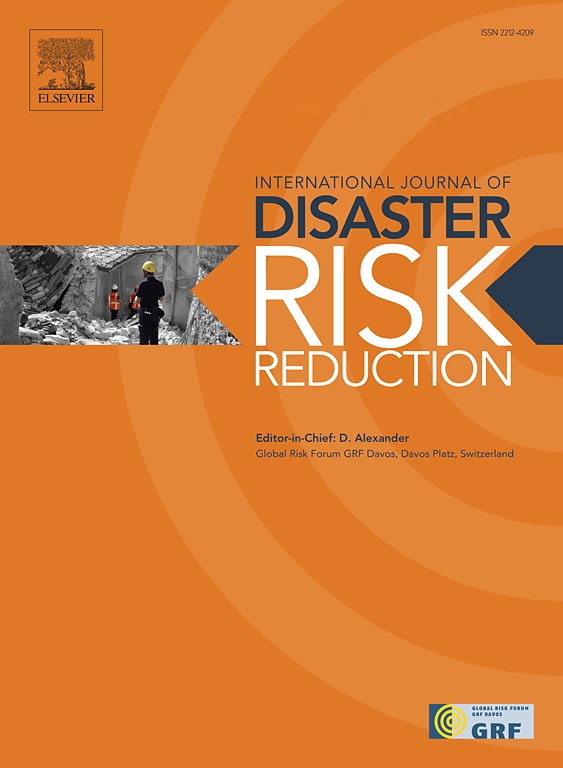Assessing road network risk performance in the United States: A standardized spatial risk analysis
IF 4.2
1区 地球科学
Q1 GEOSCIENCES, MULTIDISCIPLINARY
International journal of disaster risk reduction
Pub Date : 2025-03-21
DOI:10.1016/j.ijdrr.2025.105418
引用次数: 0
Abstract
Natural hazards can disrupt road networks, daily activities, and disaster response capabilities, making identifying high-risk areas essential for effective preparedness and response planning. Although existing research addresses road network performance risks, it offers limited insights into spatial patterns, their impact on network functionality, and their implications for disaster operations management. This paper introduces a method to evaluate road network performance risk for various natural hazards at three levels: local (node-specific analysis), regional (risk clustering based on network directions), and global (using a Standardized Spatial Risk Index). The local level considers network topology, historical hazard data, and socio-economic characteristics of the population. The regional level groups local risks by geographic orientation, while the global level assesses the overall spatial distribution of risks across the network. The paper implements the method in the United States, leveraging FEMA's National Risk Index to analyze multiple cities in California and assess risks from 18 types of natural hazards. The results highlight whether an entire city or specific areas require attention, offering actionable insights to enhance resilience through improved mitigation, preparedness, and response strategies.
美国道路网络风险绩效评估:标准化空间风险分析
自然灾害可以破坏道路网络、日常活动和灾害响应能力,因此确定高风险地区对于有效的准备和响应规划至关重要。尽管现有的研究解决了道路网络性能风险,但它对空间模式、对网络功能的影响及其对灾害操作管理的影响提供了有限的见解。本文介绍了一种基于局部(节点特定分析)、区域(基于网络方向的风险聚类)和全局(使用标准化空间风险指数)三个层次的道路网络性能风险评估方法。地方层面考虑网络拓扑结构、历史灾害数据和人口的社会经济特征。区域层面根据地理方向对局部风险进行分组,而全球层面评估风险在整个网络中的整体空间分布。本文在美国实施了该方法,利用联邦应急管理局的国家风险指数对加州多个城市进行了分析,并对18种自然灾害进行了风险评估。结果突出了整个城市或特定地区是否需要关注,并提供了可操作的见解,通过改进缓解、准备和响应策略来增强复原力。
本文章由计算机程序翻译,如有差异,请以英文原文为准。
求助全文
约1分钟内获得全文
求助全文
来源期刊

International journal of disaster risk reduction
GEOSCIENCES, MULTIDISCIPLINARYMETEOROLOGY-METEOROLOGY & ATMOSPHERIC SCIENCES
CiteScore
8.70
自引率
18.00%
发文量
688
审稿时长
79 days
期刊介绍:
The International Journal of Disaster Risk Reduction (IJDRR) is the journal for researchers, policymakers and practitioners across diverse disciplines: earth sciences and their implications; environmental sciences; engineering; urban studies; geography; and the social sciences. IJDRR publishes fundamental and applied research, critical reviews, policy papers and case studies with a particular focus on multi-disciplinary research that aims to reduce the impact of natural, technological, social and intentional disasters. IJDRR stimulates exchange of ideas and knowledge transfer on disaster research, mitigation, adaptation, prevention and risk reduction at all geographical scales: local, national and international.
Key topics:-
-multifaceted disaster and cascading disasters
-the development of disaster risk reduction strategies and techniques
-discussion and development of effective warning and educational systems for risk management at all levels
-disasters associated with climate change
-vulnerability analysis and vulnerability trends
-emerging risks
-resilience against disasters.
The journal particularly encourages papers that approach risk from a multi-disciplinary perspective.
 求助内容:
求助内容: 应助结果提醒方式:
应助结果提醒方式:


